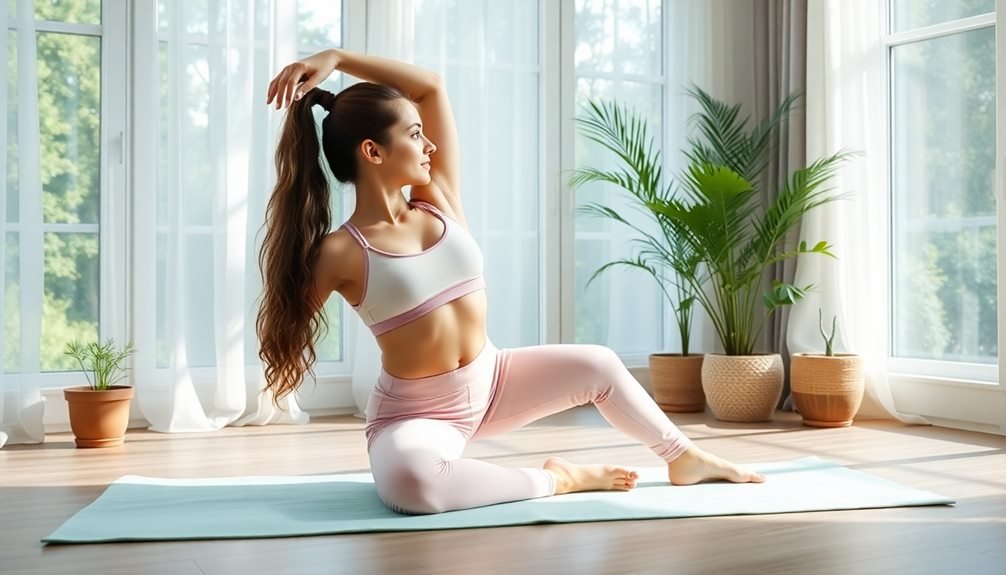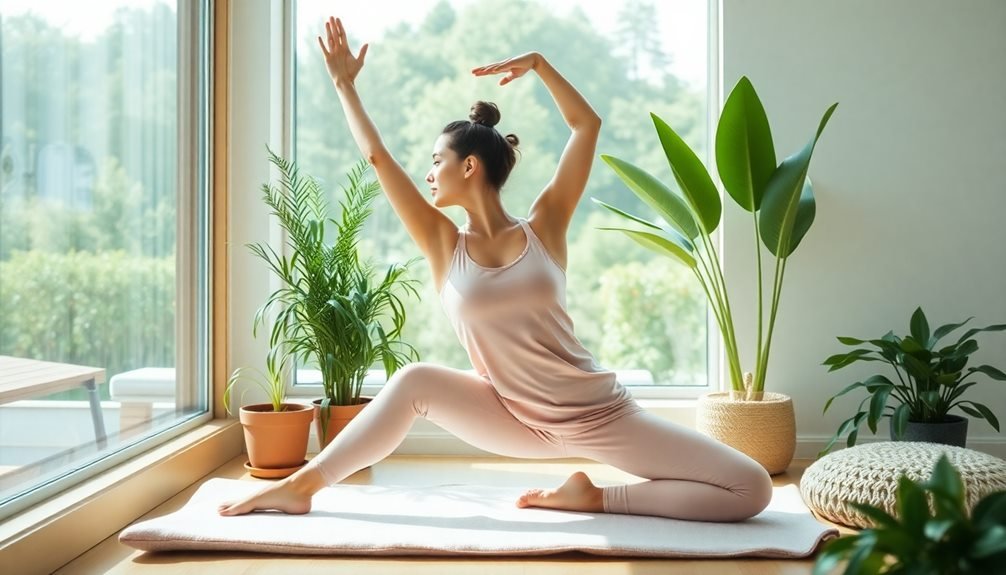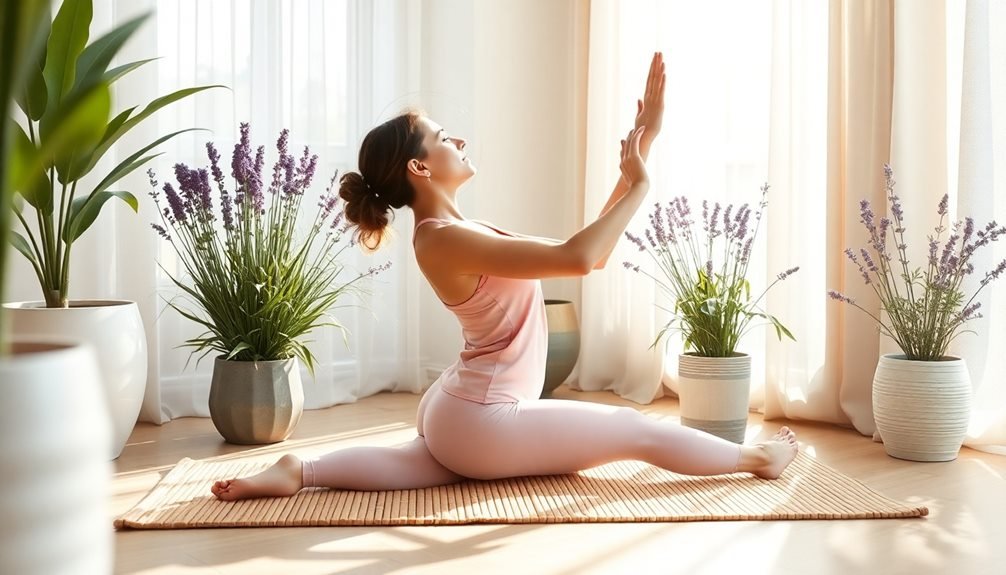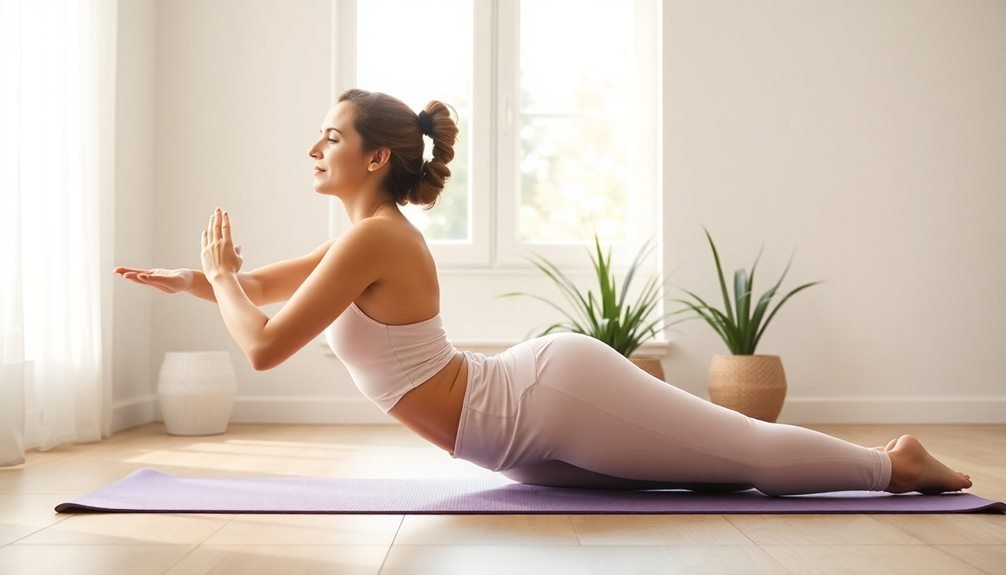Looking to reduce anxiety through gentle exercise? You'll find relief with these calming, low-impact workouts that won't strain your body. Try walking meditation in nature, gentle swimming laps, or a restorative yoga flow to center your mind. Tai chi's flowing movements and water aerobics can help release tension, while stationary cycling and light Pilates build strength mindfully. Indoor walking sessions and beginner barre workouts offer structured movement in the comfort of your home. For maximum anxiety relief, practice mindful breathing techniques during any of these soothing activities. Let's explore each workout to find your perfect anxiety-busting routine.
Walking Meditation in Nature

Many people overlook walking meditation as a powerful form of mindful exercise. By combining gentle movement with mindful awareness, you'll transform a simple walk into a rejuvenating practice that calms both body and mind.
To begin walking meditation, choose a natural setting like a park, forest trail, or garden. Start at a slow, deliberate pace and focus on each step – notice how your feet connect with the ground, how your muscles engage, and how your breath naturally flows.
As you walk, engage your senses fully: listen to rustling leaves, feel the breeze on your skin, and observe the colors and textures around you.
You don't need to maintain a specific pace or distance. Instead, let your body find its natural rhythm while staying present in the moment. If your mind wanders, gently redirect your attention to your physical sensations or surroundings.
Practice this for 15-30 minutes, gradually increasing duration as you become more comfortable.
Walking meditation offers unique benefits: it reduces stress hormones, improves circulation, strengthens muscles, and provides grounding energy – all while requiring minimal physical impact on your joints.
Gentle Swimming Laps
Swimming laps at a gentle pace offers three core advantages: it provides full-body resistance training, supports joint health through water's natural buoyancy, and promotes cardiovascular fitness without strain.
You'll find that water's resistance naturally strengthens your muscles while protecting you from impact-related injuries common in land-based exercises.
To begin your swimming routine, you'll want to start with 10-15 minutes of gentle freestyle or breaststroke. Focus on your breathing pattern, syncing it with your strokes – this helps create a meditative state while maintaining proper form.
As you glide through the water, you're engaging multiple muscle groups simultaneously, from your core to your shoulders.
The pool's consistent temperature and the rhythmic nature of swimming help regulate your nervous system, reducing stress hormones like cortisol.
You can gradually increase your duration to 30 minutes as your endurance improves. Remember to maintain a comfortable pace where you can still hold a conversation – this guarantees you're working at the right intensity for a low-impact workout.
Consider swimming during off-peak hours when pools are less crowded to enhance the calming effects of your aquatic exercise.
Restorative Yoga Flow

Starting your restorative yoga practice with basic poses like child's pose, cat-cow stretches, and gentle twists will help you build a strong foundation.
You'll notice immediate mental clarity and stress relief as you focus on coordinating your breath with each mindful movement.
Making time for these calming poses daily, even if it's just 10 minutes, can improve your emotional balance and reduce anxiety levels considerably.
Basic Poses For Beginners
Restorative yoga offers several gentle poses that'll help you ease into a regular practice while building flexibility and strength.
Start with Child's Pose (Balasana) by kneeling and folding forward with your arms extended, letting your forehead rest on the mat. This pose releases tension in your back and shoulders while promoting deep breathing.
Move into Cat-Cow stretches (Marjaryasana-Bitilasana) on your hands and knees, alternating between arching and rounding your spine. This combination helps improve spinal mobility and core awareness.
Next, try Legs-Up-the-Wall pose (Viparita Karani) by lying on your back with your legs extended up a wall, which reduces leg swelling and calms your nervous system.
Practice Corpse Pose (Savasana) by lying flat on your back with arms and legs slightly apart. This essential pose promotes full-body relaxation and mental clarity.
Finally, incorporate Easy Pose (Sukhasana), a comfortable seated position with crossed legs and an elongated spine.
You'll want to hold each pose for 3-5 minutes while focusing on steady, deep breaths. Remember to use props like blocks or blankets to support proper alignment and comfort.
Mental Health Benefits Daily
Beyond the physical elements of these beginner poses, a daily restorative yoga flow can transform your mental wellbeing. When you practice these gentle movements consistently, you'll notice reduced anxiety levels, improved sleep quality, and enhanced emotional regulation. The mindful breathing techniques combined with slow, purposeful movements help activate your parasympathetic nervous system, effectively lowering stress hormones.
| Mental Benefit | How It Works | Daily Impact |
|---|---|---|
| Stress Relief | Deep breathing triggers relaxation response | Reduced cortisol levels |
| Better Focus | Mindful movement increases present-moment awareness | Enhanced concentration |
| Emotional Balance | Regular practice builds emotional resilience | More stable mood patterns |
| Sleep Quality | Evening practice calms nervous system | Improved rest cycles |
| Mental Clarity | Meditation aspects clear mental chatter | Sharper decision-making |
You'll find that dedicating just 15-20 minutes to these restorative poses can create a powerful shift in your daily mental state. The practice builds a foundation for emotional stability while giving you practical tools to manage stress throughout your day. You don't need special equipment or extensive training – just consistency and willingness to show up on your mat.
Tai Chi Movements
You'll find that Tai Chi's gentle flowing movements work in harmony with your natural energy while promoting physical wellness and mental clarity.
Through proper breathing techniques synchronized with each motion, you're learning to maintain composure and develop a stronger mind-body connection.
As you practice balancing postures and focus inward, you'll notice improved stability, reduced stress, and enhanced overall awareness of your body's movements.
Gentle Flowing Energy Movements
Tai Chi's gentle, flowing movements offer a perfect gateway into low-impact exercise while promoting balance and inner calm. You'll find that these graceful movements help release tension while strengthening your core and improving flexibility.
As you practice, focus on maintaining fluid motion and steady breathing, allowing each movement to flow naturally into the next.
Start by learning basic movements like "Wave Hands Like Clouds," where you'll shift your weight from side to side while moving your arms in circular patterns. The "Moving the Moon" exercise involves raising your arms slowly while rotating your torso, helping to improve spinal mobility and shoulder strength.
You can also try "Gathering Chi," which combines gentle knee bends with coordinated arm movements to enhance energy flow.
When performing these movements, keep your joints relaxed and your movements controlled. Don't rush – the key is to maintain awareness of your body's position and movement through space.
If you're new to energy work, practice for just 10-15 minutes daily, gradually increasing duration as your comfort level grows. Remember to wear loose, comfortable clothing that won't restrict your range of motion.
Proper Breathing Techniques
During Tai Chi movements, proper breathing serves as the foundation for achieving maximum benefits from your practice. You'll want to focus on diaphragmatic breathing, where you inhale deeply through your nose, allowing your belly to expand naturally. As you exhale through your mouth, let your abdomen fall gently.
Coordinate your breath with each movement. When you're pushing outward or rising up, that's your exhale. When you're pulling inward or sinking down, that's your inhale. Don't force your breathing; instead, let it flow naturally with your movements. If you're new to this practice, you might find it helpful to start with a simple 4-count breath: inhale for 4 counts, hold briefly, then exhale for 4 counts.
When performing more complex Tai Chi sequences, maintain a steady rhythm with your breath. You'll notice that slower, controlled breathing helps you stay balanced and focused.
Keep your throat relaxed and avoid shallow chest breathing. As you practice, you'll discover that proper breathing not only enhances your Tai Chi form but also reduces tension and promotes a deeper mind-body connection.
Balance and Inner Focus
Mastering balance in Tai Chi begins with cultivating a strong mind-body awareness. As you practice, you'll focus on shifting your weight smoothly between movements while maintaining proper alignment. Keep your spine straight, shoulders relaxed, and knees slightly bent to create a stable foundation.
Start with these fundamental Tai Chi movements, practicing each for 5-10 minutes:
| Movement | Focus Area | Benefit |
|---|---|---|
| Cloud Hands | Upper Body | Improves coordination and relaxes shoulders |
| Single Whip | Core Balance | Strengthens legs and enhances stability |
| Golden Rooster | Standing Leg | Develops single-leg balance and focus |
Remember to breathe deeply and move slowly, allowing your mind to stay present with each shift. If you're new to Tai Chi, it's normal to feel slightly unsteady at first. You'll notice your balance improving as you practice regularly. Keep your gaze soft and focused on a point about six feet ahead of you, which helps maintain stability while performing the movements. When you feel unstable, pause briefly and reset your stance before continuing.
Water Aerobics Basics

Water aerobics stands out as one of the gentlest yet most effective forms of low-impact exercise. You'll find that the water's natural resistance provides a full-body workout while supporting your joints and reducing stress on your muscles.
Whether you're recovering from an injury or seeking a calming fitness routine, water aerobics can help you achieve your wellness goals without overwhelming your body. The pool's buoyancy lets you move freely while building strength and improving cardiovascular health.
You'll need only basic equipment like water weights and a pool noodle to get started. The water's temperature and gentle pressure can help reduce anxiety while you exercise, making it an ideal choice for both physical and mental well-being.
- Begin with shallow water exercises to build confidence and proper form
- Focus on controlled movements rather than speed to maximize benefits
- Keep your core engaged throughout each exercise for better stability
- Stay hydrated even though you're in the water
- Listen to your body and adjust intensity as needed
Remember to maintain proper breathing patterns and keep your movements fluid.
You'll discover that water aerobics can become an invigorating part of your regular fitness routine while providing therapeutic benefits for both body and mind.
Mindful Stretching Routine
Your mindful stretching routine combines a flowing sequence of gentle movements, starting with neck rolls and progressing through shoulder circles, spinal twists, and leg stretches.
You'll enhance each stretch by coordinating your breath – inhaling as you lengthen and exhaling as you deepen the movement.
Keeping your attention focused on body sensations during each stretch helps you stay present and aware of your physical limits while building a stronger mind-body connection.
Essential Stretching Flow Sequence
A mindful stretching flow sequence provides the perfect foundation for reducing tension and increasing flexibility while staying present in the moment.
You'll want to move through each pose slowly and deliberately, focusing on your breath as you shift between movements. This gentle practice helps you connect with your body while releasing physical and mental stress.
Begin in a comfortable seated position and gradually progress through the sequence, holding each stretch for 15-30 seconds.
Listen to your body's signals and don't push beyond your natural limits. As you flow through the movements, you'll notice your muscles becoming more receptive and your mind growing calmer.
- Start with cat-cow poses to warm up your spine and activate your core
- Flow into downward dog, then move through standing forward folds
- Shift to gentle warrior poses to build strength and stability
- Include seated twists to release spinal tension and improve digestion
- End with child's pose and savasana for deep relaxation
Remember to breathe deeply throughout the sequence, allowing each exhale to help you sink deeper into the stretches while maintaining proper alignment and form.
Breathing With Movement Tips
Proper breathing techniques form the cornerstone of any mindful stretching practice, creating a natural rhythm that enhances both movement and relaxation.
As you flow through each stretch, coordinate your breath with your movements to maximize the benefits of your practice.
Begin each stretch by inhaling deeply through your nose, allowing your belly to expand fully. On your exhales, breathe out through your mouth while gently deepening into the stretch. You'll want to maintain a steady 4-count breath: inhale for 4 counts, hold briefly, then exhale for 4 counts.
When shifting between poses, time your movements with your breath. Move into stretches on your inhales, and release or deepen on your exhales. If you're feeling tense in a particular area, direct your breath toward that spot, visualizing the tension melting away with each exhale.
Don't hold your breath during challenging stretches – this creates unnecessary tension. Instead, maintain steady, rhythmic breathing throughout your practice.
If you notice your breathing becoming shallow or irregular, pause and reset your breath before continuing your movement flow.
Mindful Body Awareness Exercises
Three mindful body awareness exercises form the foundation of this gentle stretching routine, helping you develop a deeper connection with your physical self.
Begin by lying on your back, scanning your body from toes to head, noticing areas of tension. Next, move into gentle cat-cow poses, synchronizing your breath with each movement while focusing on your spine's articulation.
Finally, perform slow shoulder rolls while seated, paying attention to the subtle sensations in your neck and upper back.
Throughout these exercises, you'll want to maintain awareness of your body's signals and respect its limitations. If you feel any discomfort, modify the movements or reduce their range. Remember that mindful stretching isn't about pushing yourself – it's about listening to your body and moving with intention.
- Notice physical sensations without judgment or criticism
- Observe your breath's natural rhythm as you move
- Stay present in the moment rather than rushing through movements
- Accept your current flexibility level without comparison
- Release expectations and embrace the practice as it unfolds
These mindfulness principles help create a nurturing environment for both body and mind, allowing you to fully experience the benefits of this gentle practice.
Stationary Cycling

Riding up and down on a stationary bike provides an excellent cardiovascular workout while sparing your joints from high-impact stress. You'll find it's an ideal exercise choice when you're seeking a gentle yet effective way to boost your endorphins and reduce anxiety.
The rhythmic pedaling motion can help quiet your mind while building strength in your legs, glutes, and core muscles.
To get started, adjust the seat height so your knee has a slight bend when the pedal's at its lowest point. You can begin with 10-15 minutes at a moderate pace, gradually increasing your duration and resistance as your fitness improves.
If you're using a bike with programmable settings, try the "rolling hills" program to add variety without overwhelming intensity.
Focus on maintaining steady breathing as you pedal, and don't grip the handlebars too tightly. You can make your cycling sessions more engaging by streaming music, podcasts, or scenic virtual rides.
Remember to stay hydrated and listen to your body – if you're new to exercise, start with shorter sessions and build up gradually over time.
Light Pilates Exercises
Gentle movements on a mat form the foundation of light Pilates exercises, making them perfect for anyone seeking a calming workout routine.
You'll focus on controlled breathing while performing slow, deliberate movements that strengthen your core and improve flexibility. These exercises help reduce tension in your muscles while promoting mind-body connection.
Begin with basic Pilates moves like pelvic tilts and spine curls, gradually progressing to more challenging exercises as your strength builds. You don't need special equipment – just a comfortable mat and loose-fitting clothes.
The emphasis on precise movements and proper form helps you stay present in the moment, effectively reducing anxiety and stress.
- The controlled breathing pattern in Pilates activates your parasympathetic nervous system, promoting relaxation
- Mat exercises enhance body awareness and mindfulness through deliberate movement
- Light Pilates strengthens deep stabilizing muscles without putting stress on your joints
- Regular practice improves posture and reduces chronic tension in your neck and shoulders
- The gentle nature of these exercises makes them suitable for all fitness levels and ages
Practice these exercises for 15-20 minutes, focusing on quality over quantity, and you'll notice improved flexibility and reduced muscle tension.
Indoor Walking Sessions

When the weather keeps you indoors, walking at home offers an effective and convenient way to stay active. You can create an indoor walking routine by pacing through your home's longest areas, such as hallways or around your living room. To maximize your space, try walking in figure-eight patterns or following the perimeter of each room.
You'll want to maintain proper form by keeping your head up, shoulders relaxed, and arms swinging naturally at your sides. Start with 10-minute sessions and gradually increase to 30 minutes as you build endurance. To enhance your workout, you can incorporate arm movements, knee lifts, or side steps.
Consider following indoor walking videos online, which can guide you through varied movements and help maintain motivation. You can also create an energizing playlist or listen to podcasts while you walk. Track your progress using a fitness tracker or smartphone app to monitor your steps and distance.
For extra intensity, try adding small hand weights or increasing your pace during certain intervals. Remember to wear supportive shoes, even indoors, to protect your joints and maintain proper alignment throughout your walking session.
Beginner Barre Workout
Ballet-inspired barre workouts blend graceful movements with strength training, making them perfect for beginners seeking low-impact exercise. You'll need minimal equipment – just a sturdy chair or countertop to serve as your ballet barre. The controlled movements focus on proper form and alignment while targeting major muscle groups through small, precise actions.
Begin with a 30-minute session, wearing comfortable clothing that allows you to see your form. You'll combine ballet positions with gentle pulses, stretches, and holds that strengthen your core, improve posture, and increase flexibility. The methodical nature of barre workouts helps calm your mind while building muscle endurance.
- Focus on proper foot placement and turnout to protect your joints and maximize benefits
- Maintain engagement through your core throughout each movement
- Keep movements small and controlled rather than using momentum
- Listen to your body and modify exercises as needed
- Practice regular breathing patterns to enhance mind-body connection
As you progress, you can increase the duration of holds and add more challenging variations.
Remember to maintain proper alignment and avoid rushing through movements – precision matters more than speed in barre workouts.
Frequently Asked Questions
Can Anxiety-Reducing Workouts Replace Prescribed Medication for Anxiety Disorders?
You shouldn't replace prescribed anxiety medications with workouts alone. While exercise can help manage symptoms, it's best to work with your doctor to determine the right treatment plan for your anxiety disorder.
How Long Does It Take to Notice Mental Health Benefits From Low-Impact Exercise?
You'll likely notice improved mood within 5-10 minutes of exercise, but consistent benefits develop over 4-6 weeks of regular activity. Don't get discouraged – even small amounts can help your mental well-being.
Should I Exercise During an Active Panic Attack?
During an active panic attack, you shouldn't push yourself to exercise. Instead, focus on calming breathing techniques, grounding exercises, or gentle stretching. Wait until the acute symptoms pass before starting any workout routine.
Are Group or Solo Workouts More Effective for Managing Anxiety?
You'll find both options can help anxiety, but it depends on your personality. If you're socially motivated, group workouts provide support. If you prefer solitude, solo sessions let you focus without pressure.
What Time of Day Is Best for Anxiety-Reducing Exercises?
You'll benefit most from anxiety-reducing exercise in the morning, as it sets a positive tone for your day. However, if you're an evening person, a gentle workout before dinner can help unwind your mind.
In Summary
You'll find these low-impact workouts offer both physical benefits and mental relief from anxiety. Whether you're walking mindfully through nature or flowing through gentle yoga poses, these exercises won't strain your body while helping calm your mind. Start slowly, listen to your body, and incorporate these soothing movements into your daily routine. You're taking an important step toward better mental and physical well-being.





Leave a Reply